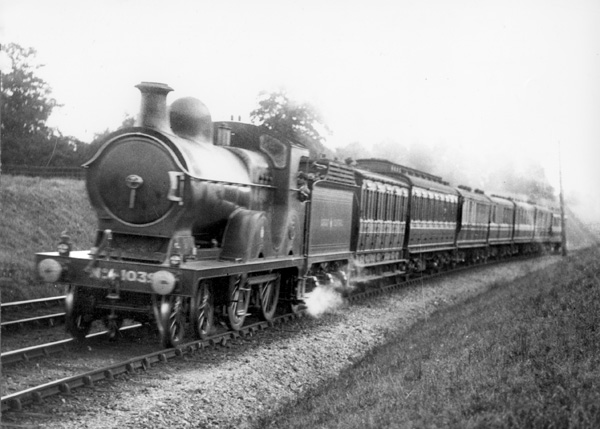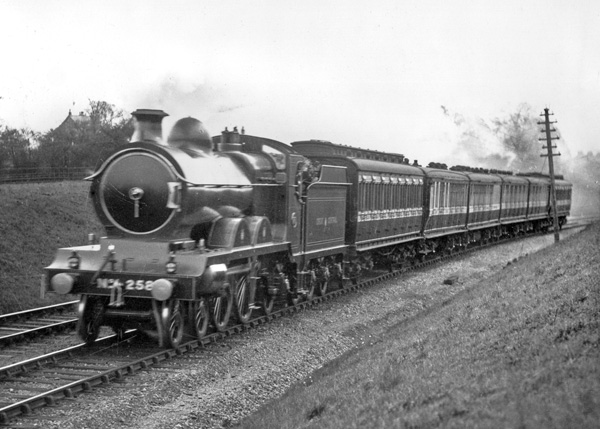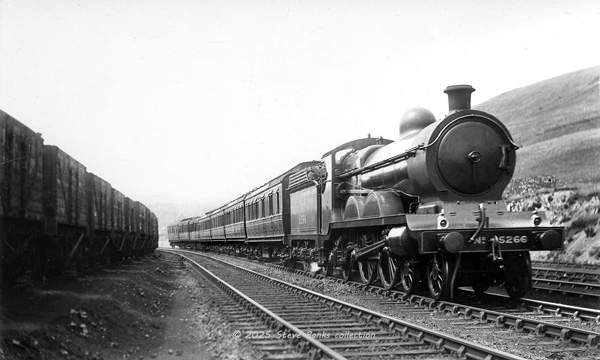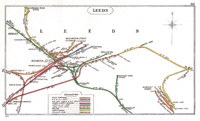GCR carriages - 50' clerestory
Revised and expanded re use of these carriages as strengtheners
This is going to be quite long because there was a cluster of designs, and several 4mm kits from the Perseverance range. I'm transferring pictures from the modelling topic and expanding them.
- CL semi-corridor lav compo - T third - BV bogie van - Strengthening of M'bone expresses by clerestories 1903-1910 - Trans-Pennine services - Strengthening in LNER days
Semi-corridor lavatory composite
Most people are familiar with this concept because of the Gresley and Thompson versions and their use in rural secondary services and this precursor by Robinson from 1903 is much forgotten. It helps to look at the Diagram first:

Click on the image for an enlargement
Design
The Robinson design was for a 50' carriage with six compartments and two pairs of lavatories whereas the later, slightly longer Gresley and Thompson designs were 51'1 1/2" and 52'4" and had a greater capacity with one more compartment and fewer lavatories:
F-L-FF-L-TTT Robinson FFF-L-TTTT Gresley
Robinson didn't want to change the standard length nor the generous 1st class compartments, 7'9" compared with Gresley's 7'3": these clerestory carriages were meant to be quite luxurious and customers of the higher class formed a relatively high proportion at the time and Robinson clearly wanted to impress. Had he compromised a little in these regards he could have fitted in an extra compartment and one fewer pair of lavatories. It should also be borne in mind that in Robinson's time, carriages were 6" narrower as well; later designers had more room to play with and both Gresley and Thompson developed the concept handsomely.
There were some other aspects:
- In the last four built the longer 1st class seats were described as sleeping berths. This remarkable innovation reduced the number of 1st class seats from 15>12. I regret to say that I have never come across their use in service. - One senses Robinson struggling with and juggling their design and another five Diagrams (4L3/4/6/7/8) were built in very small quantities, only one repeating the sleeping berths. In all the other Diagrams the number of 1st class compartments was reduced from 3>2, which would have been more suitable for rural services. - A final point is that a good proportion was built with dual brakes (Westinghouse and vacuum) for running on the NER. They were later reduced to vacuum-only.
Running numbers for 4L5 were:
80-1, 83-86 and 1644-50
with prefix "5" in LNER and in BR days, a prefix "E" as well, the total coming to 9. The other five designs were built in very small quantities and comprised another 9 carriages so the type came to 18 altogether, all lasting into BR days 1948-56. Please note that the Longworth book does not recognise the carriages with reduced 1st class seats nor de-classification to all-3rd. Diagram 4L5 was the most numerous and is covered by the Perseverance 4mm kit.
These lavatory composites were so useful in secondary services in rural districts that they were eventually cascaded to other districts and the last one wasn't withdrawn until 1956 by which time it had served for 52 years.

A fine view of lavatory composite to 4L5, No E580, in a train at Malton in 1955. To the left is a non-gangwayed ex-NER carriage and, to the right, a gangwayed Gresley. I suspect that this may have been a made-up summer Season train and the ex-GCR carriage has been declassed to all-3rd. The screened windows to the lavatories, which had originally carried the GCR coat of arms, had been replaced by plain ones by the LNER. Photo: Author's collection.
Click on the image for an enlargement
In service

A detail view from the picture below of 8B No 266 at Willesden Green with the CL second from the front.
Click on the image for an enlargement
3rd

Ex-GCR clerestory 3rd No 5131 at Banbury in 1949, as part of a train that has worked down the Banbury Branch from Woodford Halse. Photo: author's collection.
The c1914 picture above and below of the train behind 8B No 266 at Willesden Green contains two of these carriages.
Technical details to follow.
Bogie van
A history of these vans is incomplete because pictures are like hen's teeth and the parcels and newspaper traffic out of London on the Extension grew so that within a few years, Robinson had superseded these clerestory vans of 1904-5 with an elegant Parker-style version (in varnished teak in 1908), and followed in the mid-1910s with matchboard designs 56' and 60' long. In the event, Gresley and ECJS designs were soon being cascaded to the GC-Section, and eventually new builds. In other words, there was a string of developments.
I used to think that the clerestory BV disappeared from the GC Section as more modern types were introduced and survivors were converted into Instruction Cars but there are now several pictures of them still being used there in the 1930s. Photo: Roger Carpenter.

The Diagram shows the layout with large sliding doors and guard's position and duckets at the far end. GCR running numbers were: 77-83 and possibly no 84 that was withdrawn early (with first digit "5" added by the LNER). Several were originally dual braked (vacuum and Westinghouse) to permit running onto the NER, all later reduced to vacuum only. Author's collection.
For some time I have felt that these early bogie vans with a clerestory roof were cascaded to Scotland (although one of the Diagrams has a note showing re-measurement of the height which was several inches higher than first thought, and even a note stating "not to be used in Scotland"), so perhaps they were sent there and then returned? I cannot say for sure.
Several were turned into Instruction Cars with a gangway at one end, where the guard's position was retained, numbers 5, 782 and "new" 95, 650 which suggests very early conversion.
Click on the image for an enlargement

This picture of 8B No 266 c1914 descending the 1:93 at Willesden Green just south of Harrow-on-the-Hill carrying Express lights is believed to have been an extra train on the point of catching up with the early morning OP from Nottingham and Leicester to M'bone and made up from scratch, possibly an excursion or a troop special? The all-clerestory formation with two bogie vans is clear to see:
BV |
brake van |
CL |
1st/3rd lavatory |
T |
3rd |
T |
3rd |
BV |
brake van |
The leading passenger carriage with the 1st class seats and lavatories is described above. Photo: F. Moores Railway Photographs, author's collection.
Click on the image for an enlargement

This rather mucky print only shows part of the train which looks like a 50' clerestory set on the 4pm Cleethorpes-Manchester, passing Wardsend on the climb out of Sheffield behind ex-GCR B2, No 5423 Sir Sam Fay, whose allocation in the 1930s was either Sheffield or Immingham. The carriages are:
BV |
brake van |
ex-GCR 50' clerestory |
BT |
3rd brake |
ex-GCR 50' clerestory |
CL |
1st/3rd |
ex-GCR 50' clerestory with lavatory |
..... |
rem not visible |
|
These workings based an lavatory clerestories are covered under Secondary Expresses (see link below). The LNER eventually replaced them with 61'6" gangwayed stock.

This picture was probably taken in early 1939 at Harrow-on-the-Hill and shows Woodford's B7 No 5482 on what appears to the 1.20pm Leicester-Marylebone which returned vans to London. The passenger formation is a non-gangwayed 5-set with a Gresley van on the rear and, behind the tender, an ageing clerestory brake van.
Next is a 1938-built Gresley BT on steel trussing, with another example on the rear of the passenger set. I'll go into the details under that subject.
Click on the image for an enlargement
Strengthening of M'bone expresses by non-gangwayed 50ft clerestories 1903-1910
This section is copied from GCR London Extension - Express Passenger:
GCR gangwayed carriages were first built to the Parker style in 1898-1900 and again under Robinson (who maintained the GCR's house style) from 1903-08 and it's convenient to describe both as "Parker-style". Bodies initially had bow ends and were 46'6" long (brake ends with one flat end were 45'9") which Robinson raised (with flat ends across the board) to 50'.
Intended for secondary services, the non-gangwayed clerestory stock of 1903-05 was also 50' long - and followed by the 50' London Suburban designs - but the subject here concerns use up to around 1910 of the clerestory stock as strengtheners to main line expresses. There was a shortage of gangwayed stock and the GCR was cavalier in using non-gangwayed types to lengthen Parker-style 4-sets (which generally had catering), despite the fact that passengers in the strengtheners could not reach the catering, which was unfortunate given the GCR's advertising from 1903 of all its London Extension expresses carrying restaurant cars.
The Parker-style era, before the matchboard stock started arriving from 1910-11, is popular with modellers so here are five examples of strengthening by clerestories. As mentioned above, none of the photographs are dated but it would be fair to say that most of it took place on Fridays and Saturdays, especially in summer. For some modellers this may sound too confusing by half, but the real railway was flexible and these variations do give you scope for varying set formations in a pretty straightforward way.

In the first picture, 11B No 1024 is near Northwood with a Down express based on a 4-set of gangwayed Parker-style carriages. It's hard to decipher but appears to have first- and second-generation brake ends and an unidentified 12w clerestory catering carriage. The train was made up to 5 carriages by adding a 50' non-gangwayed clerestory 3rd behind the tender. Photo: LGRP.

Another 11B, No 1039, is at the same location with another express based on a Parker-style gangwayed 4-set which is too blurred to resolve, and its strengthening comprises three different non-gangwayed types. At the head is an ex-MLSR 6-wheel carriage and a GCR 50' clerestory 3rd. Another strengthener placed on the rear looks like an an ex-MSLR arc-roof design (of 1878-1896). The company was clearly short of main line carriages! Photo: LGRP

This express, hauled by Compound 8D No 258, is captioned as a Down Manchester express and its four gangwayed Parker-style carriages include a 3rd Restaurant Car (one of the batch converted from Buffet Cars), strengthened at both ends by 50' clerestory 3rds. The company may have advertised that all its London expresses contained restaurant cars but when passengers in two carriages could not be served, one wonders what the reactions were?
All four compounds were named later, albeit not very attractively to the travelling public, after senior officers of the GCR, this one The Rt.Hon. Viscount Cross G.C.B. G.C.S.I.. Photo: LGRP

This picture is an unfortunately dark contact print showing an unidentified 8B "Atlantic" passing Rickmansworth and miscaptioned as a "Down Sheffield Express". It's almost certainly the 4.30pm Manchester express which took this route with, at this time c1905, a moderate composition. It is based on a 4-set of 1899 Parker gangwayed carriages with the Buffet Car converted into a 3rd Restaurant Car:
BTK |
3rd brake | |
RT |
3rd restaurant |
|
FK |
1st | |
BTK |
3rd brake | |
T |
3rd |
clerestory |
On the rear, however, a non-gangwayed 50' clerestory 3rd has been attached. Being on the rear means that this was no last minute strengthener at Marylebone: the train would have been made up this way beforehand. Photo: Author's collection.
Click on the image for an enlargement

Seen on the line south of Harrow-on-the-Hill with a 7-carriage express is 4-6-0, No 1099 Class 8F (LNER B4 "Immingham") and it's harder to resolve. The loco was built in 1906 and the rear carriages are no longer carrying a two-tone livery, which suggests a date of around 1908-10.
On the rear is a gangwayed Parker-style 4-set carrying a single roof destination board. On the front, three extra carriages have been placed, all carrying the older livery. In the middle of this trio is another gangwayed Parker-style carriage but it is flanked by clerestory brake ends:
BT(5) |
50' clerestory |
FK(6) |
50' |
BTL(4) |
50' clerestory |
... remainder unclear... |
Note the second generation full 1st which has been included. The lavatory 3rd brake was a semi-open type with full access to the lavatories and well suited to longer journeys. I can't see any catering in this train and with such a formation, I don't think that it would have been required.
Click on the image for an enlargement
The fall of light suggests a service shown in the 1910 WTT, the Sundays-only 11.30am Nottingham-Marylebone, which operated as a semi-fast making limited stops en-route with carriages borrowed for the Sunday. Or it may have a "made-up" formation for a relief or an excursion. As in the previous examples, the company viewed the use of non-gangwayed carriages in long distance trains as fit for purpose. Scenes like this didn't disappear until many more gangwayed carriages were built to the matchboard designs in the period from 1910. Photo: Real Photos.
Trans-Pennine services
(from Secondary Expresses: Manchester-Cleethorpes
This was an interesting long distance working based on 50' a clerestory 4-set that ran with Express and Ordinary Passenger lights. In 1929 there were three daily services in each direction spread through the day with departures from:
Manchester at 5.25am, 12.40pm, 10.30pm Cleethorpes at 8.30am, 10.40am, 4.0pm.
Which required 6 sets. The trans-Pennine journey took around 4hrs and it wasn't as simple as that because several of the sets were used for other services as well, at the Lancashire and Lincolnshire ends. As far as I can tell, they carried express lights over Woodhead (with a few stops along the way) but between Sheffield and Cleethorpes, called at all stations. Some carried through carriages to and from Hull. Strengtheners were also added around the year. Crucially, perhaps, the basic formation in 1929 was a non-gangwayed clerestory 4-set dating from 1903. The whole story is too complicated to deal with here and I shall focus on two of the workings for which there are good photographs.
The first was captured around 1930 or the early '30s and is believed to be the 10.40am from Cleethorpes. It was photographed at Dunford Bridge.

In charge was B2 4-6-0 No 5426 City of Chester, which was at Sheffield and Cleethorpes around this time. Often claimed by pundts as relegated to the flatter parts of the country, the climb over Woodhead was 20 miles of around 1:100 and the loco has a clean exhaust and shows no sign of struggling. Photo: H.Gordon Tidey.
The carriages, as befitted a long journey with many stops, for which gangwayed stock was not justified, were based on lavatory stock which at first probably applied to all four carriages, the internal layout being semi-corridor. Manchester was reached at 3.17pm.
BTL |
3rd brake |
ex-GCR 50' clerestory with lavatory |
CL |
1st/3rd |
ex-GCR 50' clerestory with lavatory |
TL |
3rd |
ex-GCR 50' clerestory with lavatory |
BT |
3rd brake |
LNER 51' 1/2" |
The clerestory CL is described under "GCR carriages - 50' clerestory" (see link below). As can be seen, one of the clerestories has been modernised by a Gresley BT, albeit without lavatories. The odd thing is that it's a BT(4), none of which are recorded as allocated to the GC Section. Perhaps it had been borrowed from the GE Section or the NEA?
Click on the image for an enlargement

I hesitate to cross-reference this rather mucky print which only shows part of the train. However, it looks like the 4pm Cleethorpes-Manchester passing Wardsend on the climb out of Sheffield behind another ex-GCR B2, No 5423 Sir Sam Fay, whose allocation in the 1930s was: 1930-1933 Sheffield 1933-1942 Immingham
The carriages are:
BV |
brake van |
ex-GCR 50' clerestory |
BT |
3rd brake |
ex-GCR 50' clerestory |
CL |
1st/3rd |
ex-GCR 50' clerestory with lavatory |
..... |
rem not visible |
|
The 12.40pm from Manchester London Road was a more complex working and is described in some detail under the view of B17 No 2840 at Guide Bridge below. I have just got this eariier view from the 1920s with C4 No 5261 headibg east through Dunford Bridge:

It's a well known view that's never been captioned properly, a point already made by Leslie Franks in his "Great Central Remembered", Ian Allan (1985). Leading is the 4-set of 50' lavatory clerestories for the run between Manchester-Cleethorpes, followed by two through carriages for Hull Paragon and a bogie van:
BTL |
3rd brake |
ex-GCR 50' clerestory with lavatory |
GC.4A2 |
CL(3,4) |
1st/3rd |
ex-GCR 50' clerestory with lavatory |
GC.4L2 |
CL(3,3) |
1st/3rd |
ex-GCR 50' clerestory with lavatory |
GC.4L5 |
BT |
3rd brake |
ex-GCR 50' clerestory |
GC.3A2 |
The Hull portion I cannot identify beyond saying that it's a gangwayed Parker and another 50' clerestory, possibly (CK,BT). The bogie van on the rear is an ex-GNR Gresley 51'1 1/2" milk brake in general parcels service which will also be detached at Sheffield, possibly for King's Cross. H.Gordon Tidey, Lens of Sutton.
Click on the image for an enlargement
A later view c1935 of the 12.40pm from Manchester leaving Guide Bridge shows the formation being modernised with ex-GCR non-gangwayed matchboards for Cleethorpes and 61'6" Gresleys for Hull:

Click on the image for an enlargement
Recently built (May 1933) early B17 with a short tender No 2840 Somerleyton Hall [Gorton] has paused at Guide Bridge and is restarting the train on the climb to Woodhead towards Sheffield on Tuesday, 19th September 1933. In the background is the footbridge to the goods yard and shed, St. Stephen's church, three cotton mills: Guide Mills, Duncan Mill and Birch St. Mill, and extensive yards. Photo: R.D. Pollard, LNER PRO TP/259.
I should say at this point that this image appears on Facebook under "Sir Nigel Gresley" where it is credited to the Eric Fry collection and miscaptioned as the "12.36pm" departure, followed by a history of the hall near Yarmouth! I don't propose to say any more about the good ol' choo-choo, rather the service and the train's mixture of ex-GCR and LNER Gresley carriages. It was timetabled as a "Through Train Manchester London Rd. to Cleethorpes" but stopped at many of the stations along the way in the manner of an Ordinary Passenger train and for which a non-gangwayed lavatory 4-set was provided, but it also conveyed two gangwayed through carriages for Hull part of the way.
The formation for the first leg to Sheffield was:
BTL |
3rd brake |
ex-GCR 50' clerestory with lavatory |
|
T |
3rd |
ex-GCR 60' matchboard |
|
CL |
1st/3rd |
ex-GCR 60' matchboard with lavatory |
|
BTL |
3rd brake |
ex-GCR 50' clerestory with lavatory |
|
------ |
------------------------------- |
----------------------------------------------- |
|
BCK |
1st/3rd brake |
Gresley 61'6" |
to Hull Paragon |
TK |
3rd |
Gresley 61'6" |
to Hull Paragon |
------ |
------------------------------- |
----------------------------------------------- |
|
B |
4w passenger brake van |
D.120 clone |
|
The working is best broken into its four constituent parts:
Manchester-Sheffield - Along this leg the Manchester suburban stations were not served nor wayside stations in the Pennines. However, stops are believed to have been made at Guide Bridge, Glossop and Penistone (the PTT confusingly includes a connecting local service to the wayside stations).
Hull portion - the train arrived at Sheffield Victoria at 1.58pm whereupon the two gangwayed carriages were left behind and transferred by the station pilot to the 2.10pm departure from Sheffield to Hull which was ready and waiting. It was an NEA 4-set from Hull almost certainly made up with ex-NER carriages, probably clerestory in the main (BT,CL,T,BT) and hauled by a modest tender loco.
4w van on the rear - is not mentioned in the 1929 or 1935 CWB and its destination is not known. It could also have gone on to Hull but there was parcels traffic between Manchester, Sheffield and Cleethorpes and it may have been part of that.
Sheffield to Cleethorpes - for the final leg the train comprised just the non-gangwayed 4-set. In 1929 this had a similar roster but was probably made up entirely with 50' lavatory clerestories dating from 1903. Modernisation was taking place when this photograph was taken with two of the carriages replaced by Robinson matchboards, only one of them still with lavatories. There was a more modern 60' matchboard equivalent for the clerestory BTL but the older ones were kept on, at least for this formation. The route was Sheffield-Retford-Grimsby-Cleethorpes which was an all-stations service and would have carried Ordinary Passenger lights with a fresh loco taking over from the B17 at Sheffield.

Click on the image for an enlargement
The drawing from the Diagram of the GCR 60' lavatory composite - which I shall work up in greater detail in the non-gangwayed carriages section - see link below for the 60' 3rd - shows what a well thought out design it was with four 1st class compartments and three 3rd - CL(4,3). With three pairs of lavatories to which all the passengers had access.
Incidentally, the "O" in the title stands for Ordinary, a term sometimes mistranslated as "Open". It was used by several companies, including the LNER. Author's collection.
Conclusions
This is a good illustration of how a set of carriages could be utilised to run part of the way as an Express and the rest of the way as an Ordinary Passenger, for which pre-Grouping non-gangwayed lavatory stock was still being used. Plus the conveyance of two through carriages to the ex-NER station at Hull for which modern 61'6" Gresleys had been provided. It's not hard to model if you already have an ex-GCR secondary 4-set.
Later developments - In 1935 this set still had the same formation but strengthening was required on Saturdays in July and September (T) and even more heavily in summer (3T). They would probably have been older rather than newer stock. The train had been accelerated with a departure of 10.50am and by 1937, given gangwayed stock (BTK,CK,TK,BTK), with which strengthening was reduced to a single carriage, albeit non-gangwayed (T). Two sets were now in use, both gangwayed, a trend that picked up in the late 1930s for long distance secondary services.
Strengthening in LNER days

Sometime in the early 1930s, No 5503 Somme has a Marylebone-Manchester express, probably the 12.15pm ex-Marylebone, near Wardsend on the 1:132 climb from Sheffield to Woodhead. In 1929 the formation at this point was a Gresley 5-set:
BTK,CK,RF,TO(dining),BTK
plus at the head if required, a "bogie third" from Sheffield. On this occasion it was a non-gangwayed 50' clerestory semi-corridor CL to GC.4L5 as shown above. As can be seen, the practice of using these carriages to strengthen expresses in summer lasted a long time. Photo: Roger Carpenter.

Also near Wardsend with the same express is No 5509 Prince Albert. Between 1929-39 the summer strengthening was revised to two bogies 3rds which ran on Saturdays Only the whole way from Marylebone and this may be what this photo shows. A similar 50ft clerestory CK was placed behind the tender and, behind it, an ex-ECJS 58'6" TK. As in the first picture, access to lavatories would have been assured in both carriages but from the non-gangwayed clerestory, not to the restaurant car! Photo: Roger Carpenter.
Click on the image for an enlargement
Related links:


